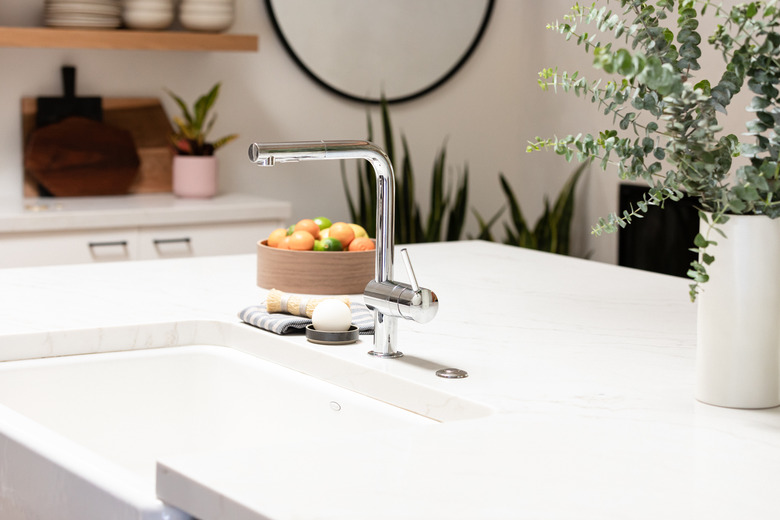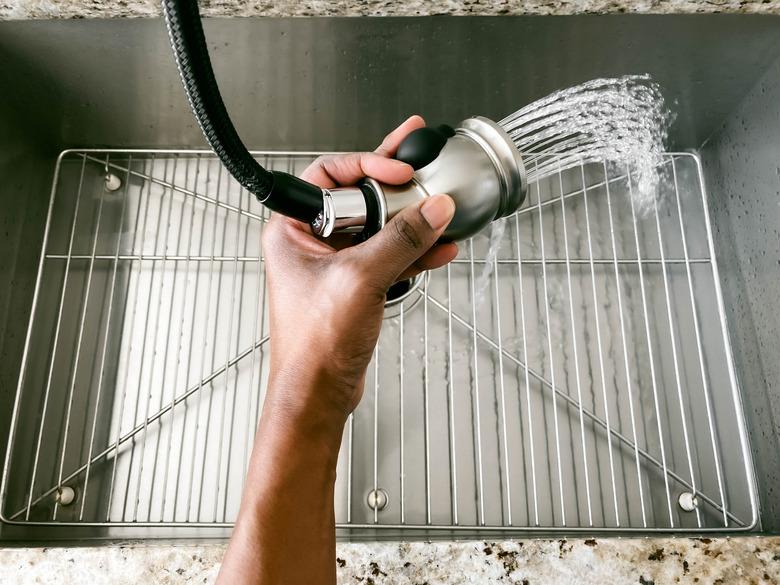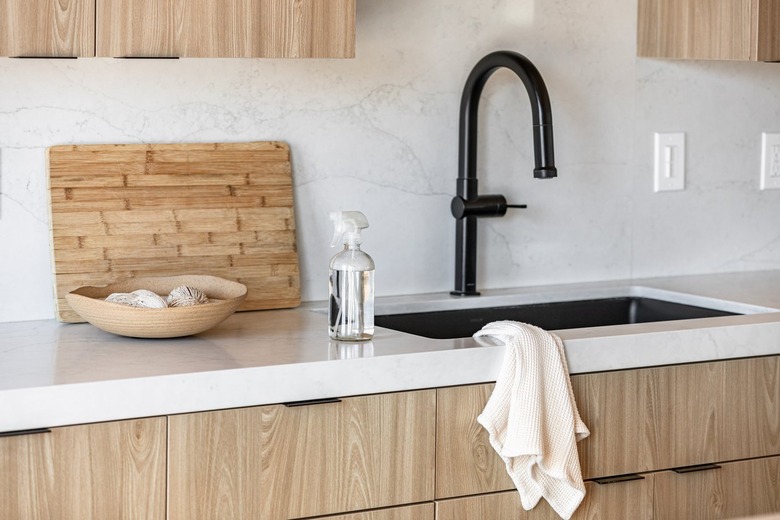What Is A Low-Arc Kitchen Faucet?
When it is time to choose a kitchen faucet, one of the first decisions you will need to make is whether you want a high-arc or low-arc design. The choices won't stop there, however, and this decision will affect many of the others you make, such as what type of spray hose you can get. The decision can be a difficult one, but it is also one that your kitchen layout could make for you.
High-Arc vs. Low-Arc Faucets
Some kitchen faucets stand quite tall above the kitchen sink. The spouts on these faucets, known as high-arc faucets, typically stand about 8 to 10 inches above the kitchen sink plane. Low-arc kitchen faucets, however, sit only 3 to 8 inches above the sink plane, according to Moen. Both have very different aesthetics, but they also function differently.
Professional chefs and home cooks who spend a lot of time in the kitchen both tend to prefer high-arc faucets. The primary reason for this is that a high arc offers more workspace in the sink. This extra space makes it easier to fill large pots and to wash large pots and pans by hand. Due to their height, however, high-arc faucets are much more prone to splashing.
Low-arc faucets may not be the favorite of professionals, but they definitely have their place. If your sink sits below kitchen cabinets or shelves, a low-arc faucet may prove to be a much better fit for your space. Low-arc faucets also tend to be more utilitarian and blend into the background better than high-arc faucets, which are often hard to miss. A low-arc kitchen faucet also won't interrupt the view if you happen to have a great one from the window above your kitchen sink.
High-Arc Faucets
- More sink space for food prep
- Prone to splashing
- A focal point in the kitchen
Low-Arc Faucets
- Ideal for smaller kitchens
- Utilitarian
- Low-profile
Arc and Spray Hoses
Although you may not use it all the time, having a spray hose on your sink can really come in handy. You can absolutely have a spray hose no matter what type of faucet you choose, but a low-arc faucet will limit your options a bit.
The most ergonomic type of sprayer is a pull-down sprayer, in which the entire spout of the faucet pulls straight down toward the sink. Unfortunately, pull-down sprayers are only available on high-arc faucets. If you do opt for a pull-down sprayer, make sure it uses a magnet to dock the sprayer when it is not in use, as this is the most reliable method.
A pull-down sprayer is not an option with a low-arc faucet, but don't count the low-arc out just yet. You can still get a pull-out sprayer with a low-arc faucet. In this arrangement, the entire end of the kitchen spout pulls out toward you when you need it rather than down into the sink. This setup is a tad less ergonomic but offers a longer hose and more flexibility.
Whether you opt for a high-arc or low-arc kitchen faucet, you always have the option of a conventional side sprayer. As its name implies, the side sprayer is its own separate part that sits next to the faucet rather than tucking up inside it. A side sprayer requires an extra hole in your sink or counter and may offer a bit less water pressure than a pull-down or pull-out sprayer, but it is usually the most flexible option and works with any faucet setup.
Water and Temperature Control
Once you decide what type of faucet arc you want, you will need to decide how you want to turn it on. The most basic option is the traditional style with separate knobs for the cold and hot water control. This setup has served many faucets over the years, and it is one with which we are all familiar. It also provides the most precise water temperature control. It is rather inconvenient, however, when you need to turn on the faucet and your hands are dirty.
If you have at least one clean hand, the single-lever setup works a bit better. In this style, a single lever pulls up to turn the water on and then swivels left and right to control the temperature. The main advantage of a single-handle faucet is that you don't need to adjust the water temperature every time you turn it on. You can set the temperature where you want it and then push down the lever to turn off the water. If you pull the lever back up without turning it, the water temperature will remain the same when you turn it back on.
Thanks to modern technology, you can also have a touch faucet. Simply bump the faucet with your hand or elbow to turn it on. Motion sensors are also an option, and although you have more room to wave your hands around under a high-arc faucet, they will work just fine with a low-arc faucet too. Both motion sensing and touch faucets require battery-operated sensors, but you can ask your electrician to hide an electrical outlet under your sink and bypass the need to change batteries.
Sink Openings
When purchasing a new sink, you will need to take your faucet choices into account. If you have opted for a low-arc kitchen faucet with a side sprayer and separate hot and cold water knobs, for example, you will need a sink with four holes on the deck to accommodate this setup. If you choose a high-arc faucet with a touch sensor and pull-down sprayer, you will need only one hole. If you are buying a new sink, you can choose whatever faucet style you like and then purchase a sink with the proper number of openings.
Things get a bit more complicated if you are replacing your faucet but not your sink. In this case, your design choices will be limited by your existing setup. You can always go with a setup that requires the same number of fixtures as what you currently have. You can also choose a style with fewer pieces and simply install a finishing plate over any unused openings in your sink deck. Adding pieces, however, is generally not an option.
Undermount sinks are the exception to these rules. In most cases, undermount sinks are glued to the bottom of the countertop, and the faucet is mounted directly to the counter. In this case, you will be bound by the number of holes in your counter rather than the holes in the deck of your sink. Again, however, adding fixtures proves difficult since it involves drilling holes in what could be a tough countertop (such as granite) as well as running additional plumbing.
Kitchen Faucet Finishing Touches
You have made a lot of decisions so far about your new kitchen faucet, but you're not quite done yet. You still need to choose the finish. The most popular choice for kitchen faucets no matter their arc height is chrome. It is durable and easy to keep clean, so it is easy to see why it is popular. It will show fingerprints and water spots, however.
Bronze faucets have an attractive and somewhat rustic brown hue but is subject to pitting over time. Nickel finishes, sometimes sold as stainless steel, are very durable, but like chrome, they do show fingerprints and water spots if you forget to wipe them down. Matte-black faucet finishes are also becoming quite popular and match almost any kitchen style.
Whatever finish you choose, there are two keys to getting it right. The first is to match the cabinet handles, drawer pulls, towel racks and other fixtures in your kitchen. The other is to avoid trends. It is OK to go with a funky color that matches your kitchen or to take a tempered style risk, but avoid trends that are popular now but will only serve to date your kitchen later.
How to Install a Kitchen Faucet
While there is certainly no harm in calling a plumber to install your new kitchen faucet, you can save yourself a few dollars by tackling the job yourself.
- Turn off the water valve under the sink and turn on the faucet to drain the supply lines.
- Remove and disconnect the old faucet.
- Clean away any old gasket sealer or residue from the sink.
- Install the new gasket and trim ring according to the manufacturer's instructions.
- Feed the faucet hoses or tubing down through the hole in the sink and then secure the faucet with retaining nuts; these are threaded on and tightened from the underside of the sink or countertop.
- Connect your water supply lines, turn the water back on and check for leaks.
- Remove the aerator from the end of the spout and then run water through the faucet for a few minutes to clear out any debris.
- Reinstall the aerator and enjoy your new faucet.
Kitchen Faucet Reach vs. Height
While the arc of your faucet tells you how high the faucet sits, you also need to be concerned with a faucet's reach. The reach on a faucet measures the horizontal distance from the center of the spout base to the water as it comes out. If your spout's reach is too short, you are likely to bump your hands and any dishes you are washing off the back of the sink. You may also find that a short faucet doesn't reach your entire sink if you opt for one with two or three bowls.
Ideally, the reach of your faucet should be such that when turned on, the water from your faucet runs directly into the drain rather than hitting the bottom of the sink. Measuring the reach on your sink before you shop for a faucet will help you pick the right size.
Both high-arc and low-arc faucets come in a wide variety of styles that allow for both long and short reaches. Keep an eye on the aesthetics rather than just the numbers when choosing, however. A high-arc faucet with a long-enough reach to cover a three-bowl sink may look awkward and ungainly. A low-arc faucet with a short reach, in contrast, may look short and stubby.


